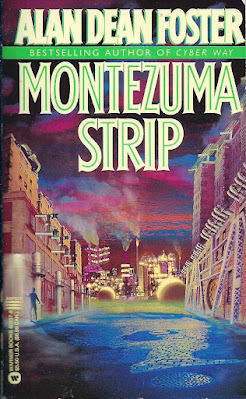When cyberpunk came on the scene, unsurprisingly, Foster embraced the genre. Starting in 1988, under the pseudonym 'James Lawson,' he published five stories in the digests Amazing and The Magazine of Fantasy and Science Fiction, these featuring a Chicano detective named Angel Cardenas.
In 2002 Foster published a full-length novel, titled 'The Mocking Program,' featuring Cardenas.
Cardenas lives in a near-future USA where the border with Mexico is more a concept than a reality, and high-tech corporations, maquiladoras, and the underclass compete for money and power in the region from Los Angeles ('LaLa') east to El Paso ('East Elpaso Juarez'). In this eponymous Strip, Cardenas has value as an 'intuitive,' meaning he can assess whether someone is being honest, or concealing something, when speaking. This quality of being a human lie detector makes him an important member of the Nogales, Arizona, federales office.
Foster's diction get can rather florid, especially when it comes to hardboiled similes:
There were at least a dozen gangs that called Puerto Penasco home.....They lived in a condition of colloidal anarchy, battling among themselves as often as with rivals. This made it tough on the local federales, since a gang member one week might metamorphose into an independent skim artist the next.
***
....they clung to the flanks of the plants like whale lice to favored cetaceans.
***
Wormy G tied his boat up beneath the gaping maw of an old, broken piling that looked like a leviathan's half-extracted tooth.
***
....the captain shuffled through a pile of printouts on his desk like an aborigine digging for edible grubs before finally shoving a hard copy at his guest.
***
As well, I came across the words and phrases 'elutriate,' 'omphalos of noplace,' and 'chalcedony,' so readers of 'Montezuma' will need to gird themselves for some thickened prose..........
Anyways, my capsule summaries of the entries in 'Montezuma Strip':
Sanctuary (Amazing, 1988): Cardenas and his dog Charliebo are assigned to investigate the mysterious deaths of two programmers, Wallace Crescent and Vladimir Noschek, who were the top programmers at their respective companies. Something, or someone, has performed a remote lobotomy on the programmers, and may be looking for other victims.
This story starts out well enough, but as it progresses the plot becomes overly complicated (real-world scientist Rupert Sheldrake, and his theory of 'morphogenetic fields,' is invoked) and the proto-Singularity phenomenon that underlies the denouement is a bit contrived.
Heartwired (The Magazine of Fantasy and Science Fiction, 1992): an incel named Wormy G hangs out with the Teslas gang, mostly because Nita, gangleader Paco's girlfriend, will sometimes smile at Wormy. Could love be a possibility ? This story is well served by a street-level perspective, and a touch of pathos.
Gagrito (The Magazine of Fantasy and Science Fiction, 1993): the Strip has a booming trade in 'magimals'; these are animals that have been outfitted with wireless controller chips and circuitry that allow the animals to be manipulated into walking on their hind legs, opening doors, operating simple machines, or even speaking. A band of animal rights activists are taking violent action against the sellers of these altered species.
Hellado (Amazing, 1993): Esteban and Chuy come up with a scheme to raid the cargo cars in the train yard. They discover something disturbing in one of their targets........
Our Lady of the Machine (Amazing, 1994): a holographic manifestation of the Madonna is shaking down business owners. Those who won't come across, wind up dead.
Summing up, 'Montezuma Strip' joins the 'Budayeen' novels of George Alec Effinger as foundational works that meld the crime / private eye and cyberpunk genres. In this regard, Foster and Effinger laid the groundwork for later novels in this genre, such as the 'Carlucci' books of Richard Paul Russo, 'Noir' by K. W.
Jeter, and 'Black Glass' by John Shirley. If you like those novels, you're going to like 'Montezuma Strip.'
























































.jpg)
.jpg)
















